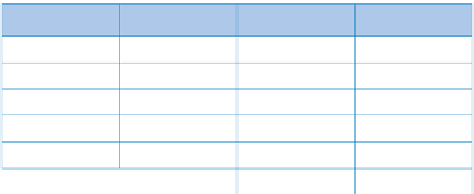Geography Reference
In-Depth Information
where
x
i
and
y
i
are the
x
and
y
locations for node
i
. In Figure 4.1 a simple polygon
feature is shown. h e
x
and
y
coordinates of its nodes and the calculations following
the equation are given in Table 4.1. Note that
x
i
+ 1
refers to the next node in the list and
x
i
- 1
is the previous one. For the i rst node (node 1) the previous node is the last node
in the list (in this example, node 5).
As an example, we take the
y
coordinate of node 1 and multiply it by the product
of the
x
coordinate of the next node (obviously, node 2) minus the
x
coordinate of
the previous node (node 5 in this case). Next, we take the
y
coordinate of node 2 and
multiply it by the product of the
x
coordinate of the next node (node 3) minus the
x
coordinate of the previous node (node 1 in this case). h is is done for each node and
the results summed and multiplied by 0.5. Note that the procedure should be followed
in a clockwise direction, if it isn't then the area returned will be negative.
In this case the area,
A
, is given by 0.5 ¥ 48 = 24.
h e procedure works for any polygon, whatever its degree of complexity. Calcula-
tion of areas of polygons is also demonstrated by Kitchin and Tate (2000) and Wise
(2002).
7
6
5
4
3
2
1
0
0
1
3
2
4
5
6
7
8
9
X
Figure 4.1
Simple polygon feature.
Table 4.1
Simple polygon nodes and area calculations
Node
x
i
y
i
y
i
¥
(
x
i
+
1
-
x
i
-
1
)
1
2
1
1
¥
(1
-
8)
=-
7
2
1
4
4
¥
(3
-
2)
=
4
3
3
6
6
¥
(7
-
1)
=
36
4
7
6
6
¥
(8
-
3)
=
30
5
8
3
3
¥
(2
-
7)
=-
15
Sum
48







Search WWH ::

Custom Search